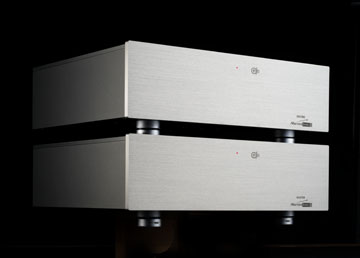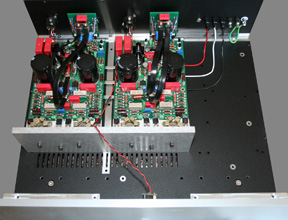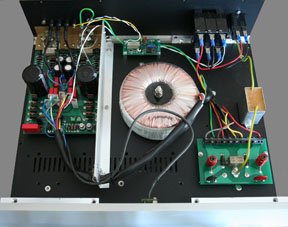Encore Amplifier
 Back in 1986, Cello introduced the Performance Amplifier which was designed to provide the most natural sound and widest dynamic range from recordings. The new Cello Encore amplifier is the first amplifier to really sound like a Performance Amplifier because it uses the driver board from the original Performance, updated to modern parts and assembled using traditional techniques.
Back in 1986, Cello introduced the Performance Amplifier which was designed to provide the most natural sound and widest dynamic range from recordings. The new Cello Encore amplifier is the first amplifier to really sound like a Performance Amplifier because it uses the driver board from the original Performance, updated to modern parts and assembled using traditional techniques.
(Read reviews)
Rated at 125w/ch @8ohms the stereo Cello Encore amplifier comes in two chasses with the amplifier channels residing separately from the Cello Master power supply in exactly the same way that the Cello Chorale preamplifier is powered by the Cello Master supply.
(See owner's manual)
The Cello Encore amplifier from Matthew James incorporates a number of engineering advances which allow high performance in a compact and efficient design, providing a practical and appealing product for inclusion in music systems of the highest quality. The circuitry is exceptionally stable and can be used with speakers which present loads as low as 1ohm.
The Encore is designed to have the lowest possible levels of distortion while under actual use, as opposed to measuring well simply on a test bench. The circuitry is designed to perform well under the complex resistive, reactive and regenerative loading which loudspeakers present to an amplifier. And again, it does so without adding additional forms of distortion before the overload threshold is reached. The design approach has been to place importance on the requirements of actual music reproduction. Many amplifiers utilize some form of soft-clip circuitry to deal with overload. The problem is that many of these approaches introduce additional forms of distortion before the actual overload threshold is reached. Furthermore, most designs to control overload are not comprehensive in dealing with all of the situations that negatively affect an amplifier’s ability to remain stable under demanding situations. The Encore has been designed to control all three forms of overload under all conditions.
Considerable effort has been made to reduce low frequency errors, because most of the energy in music and film sound reproduction is present in this part of the frequency spectrum. It is crucial to maintain low intermodulation distortion of low level, high frequency information in the presence of large low- and mid-frequency signals under complex loading. The Encore is designed to have the lowest distortion at small signal levels and to gradually increase with signal level. While this results in slightly higher total harmonic distortion (THD) measurements at full power levels, it conversely allows for the lowest possible distortion under actual listening conditions. Again, the requirements for accurate music reproduction have taken precedence in all design decisions.
All electrical connections for signal flow within the Encore are accomplished via flat, very pure silver and copper cables insulated with Kapton. The chassis is manufactured with heavy aluminum plates on all six sides. (3) Three specially designed feet, utilizing ball bearings of hardened steel with a proprietary coating, eliminate the possibility of surface-borne disruptions from affecting the performance of the circuitry.
The input stage of the Encore amplifier remains under control under any overload condition. The design tactics were chosen because they provide wide dynamic range and provide a greater measure of resistance to overload than other possible choices.
 The output stage of the stereo Encore employs one pair of 250 watt, metal case, bipolar output devices per channel. The number and type of devices were chosen because they remain stable with a less complex circuit, requiring less negative feedback, and are easier to match to each other than other possible choices for this stage. The choice of devices, the location of devices on the heat sinks, and the heat sinks themselves were carefully considered to minimize the temperature variations among the output devices. The power devices are mounted with all metal hardware, compression washers and special graphite and metal composite gaskets to insure maximum thermal conductivity and full utilization of the output devices. Once again, consistent performance, stability and reliability under normal conditions of actual use were the driving factors in the design.
The output stage of the stereo Encore employs one pair of 250 watt, metal case, bipolar output devices per channel. The number and type of devices were chosen because they remain stable with a less complex circuit, requiring less negative feedback, and are easier to match to each other than other possible choices for this stage. The choice of devices, the location of devices on the heat sinks, and the heat sinks themselves were carefully considered to minimize the temperature variations among the output devices. The power devices are mounted with all metal hardware, compression washers and special graphite and metal composite gaskets to insure maximum thermal conductivity and full utilization of the output devices. Once again, consistent performance, stability and reliability under normal conditions of actual use were the driving factors in the design.
 An important part of the Cello philosophy is found in the physical separation of the power supply from the active circuitry of either the preamplifier or the amplifier. The external Master power supply includes a mu-metal shielded transformer and an initial stage of regulation. The DC signal is again regulated within the Chorale with individual regulators for the + and – portions of both the input and output sections. Precision 10 turn trimpots allow exact calibration of tracking voltages. DC voltages are transported from the Master to the Chorale and Encore via substantial, teflon shielded, copper cables terminated with a heavy duty connector at the Encore and with substantial copper/rhodium spades at the Master.
An important part of the Cello philosophy is found in the physical separation of the power supply from the active circuitry of either the preamplifier or the amplifier. The external Master power supply includes a mu-metal shielded transformer and an initial stage of regulation. The DC signal is again regulated within the Chorale with individual regulators for the + and – portions of both the input and output sections. Precision 10 turn trimpots allow exact calibration of tracking voltages. DC voltages are transported from the Master to the Chorale and Encore via substantial, teflon shielded, copper cables terminated with a heavy duty connector at the Encore and with substantial copper/rhodium spades at the Master.









